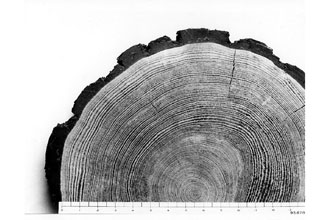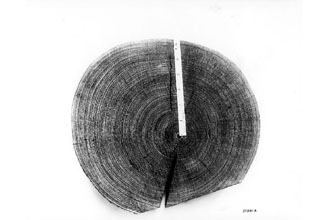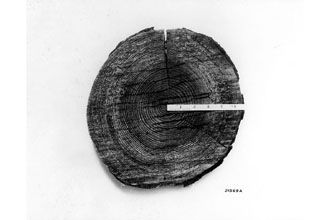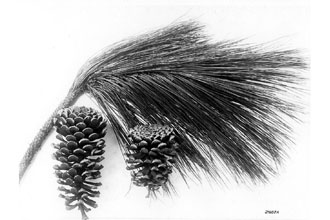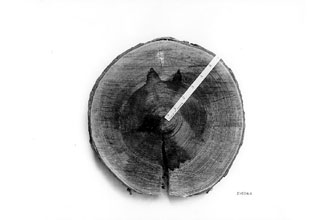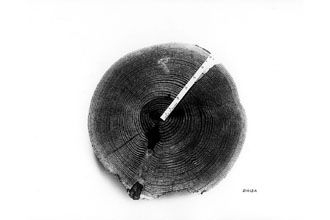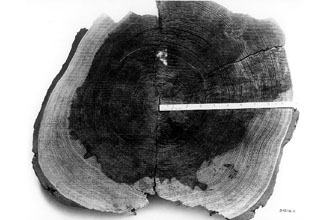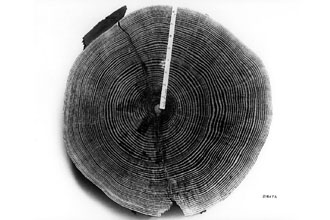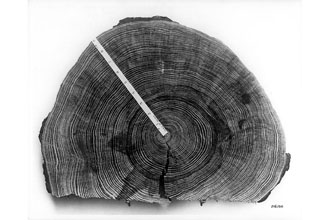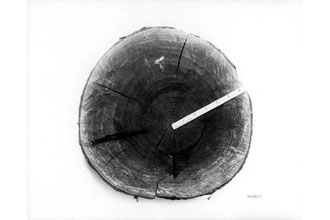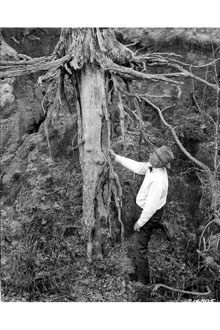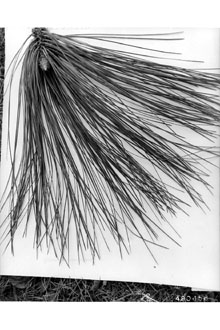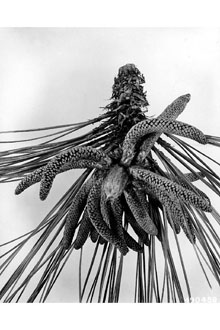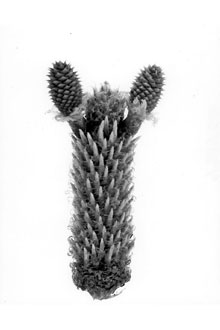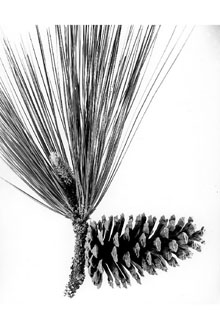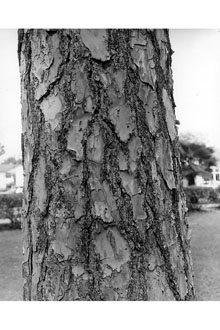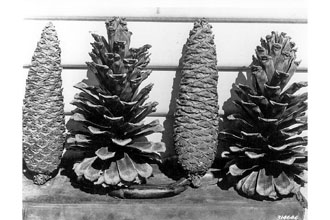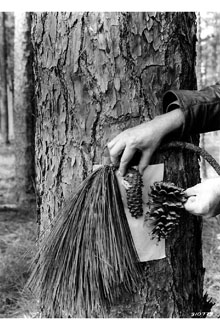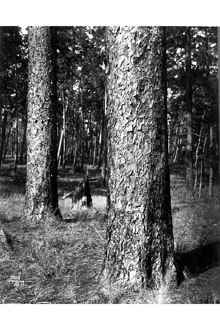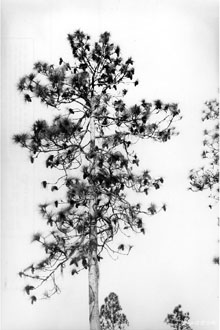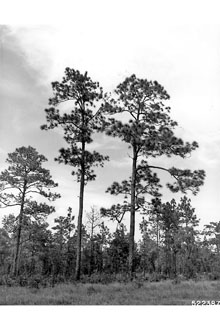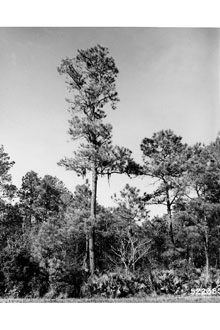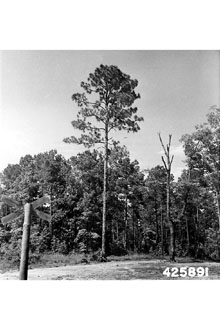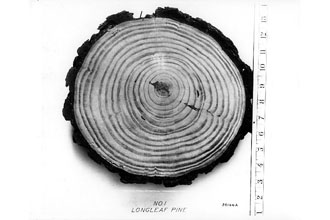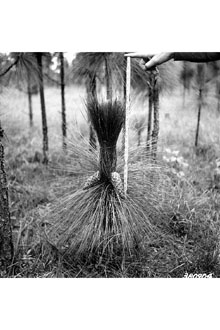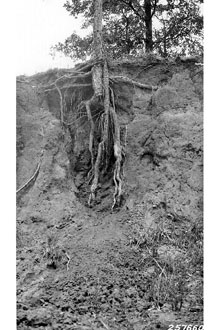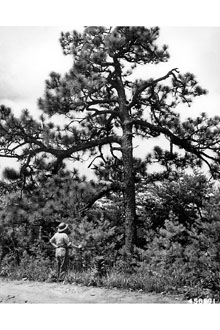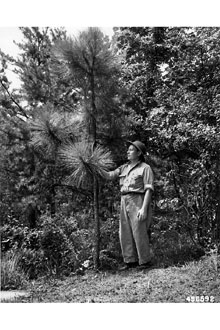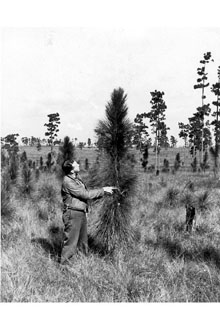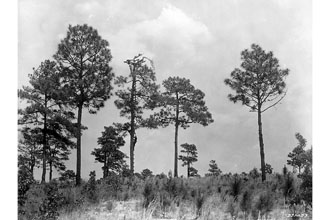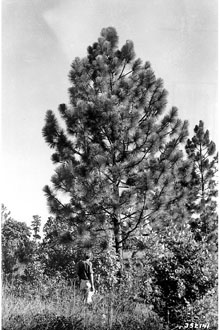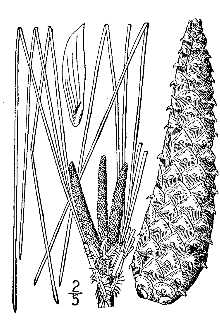Pinus australis Michx. f.
Scientific Name: Pinus australis Michx. f.
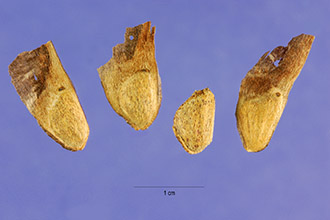
| General Information | |
|---|---|
| Usda Symbol | PIAU3 |
| Group | Gymnosperm |
| Life Cycle | Perennial |
| Growth Habits | Tree |
| Native Locations | PIAU3 |
Plant Guide
Alternate Names
Hard, Longstraw, Pitch, Fat, Southern Yellow, Swamp, Yellow or Georgia Pine
Uses
Cultural: Grooveless stone axes and adzes found in archaeological contexts in the southeastern United States reflect considerable Indian use of wood resources in southeastern forests (Delcourt et al. 1993). One of the most important of these wood resources was the pines. Pines had many uses among southeastern tribes, but often the kind of pine used is not identified. Given that in the past, longleaf pine dominated many landscapes in the Southeast, it is likely that it was utilized for many of the purposes described here. The Choctaw made darts that were used in blowguns from splinters of pine, sharpened at one end (Bushnell 1909). Tribes of the Southeast used pine wood for house frames, canoes, frames for skin boats or rafts, and bows (Swanton 1946). The Creek and Choctaw used pine bark to cover the roofs of their houses (Swanton 1931, 1946; Walker 2004). The Cherokee made canoes out of logs of large pines and they were hollowed Figure 2. Choctaw Village near the Tchefuncte River, an oil painting by François Bernard, Bonfouca, St. Tammany Parish. La., 1846. Notice the log cabin and summer arbor. Both are probably made of longleaf pine wood and observe the longleaf pine forest in the background. Courtesy of the Peabody Museum of Archaeology and Ethnology, Harvard University: 41-72-10/27. out with fire and scraped and chipped with oyster shells and stone hatchets (Swanton 1946; Catesby 1731-43). Longleaf pine was used for torches for fishing and hunting at night, as fuelwood and tinder for heating and cooking, and village streets were paved with pine bark (Earley 2004). Pines are considered by the Cherokee to have eternal lives, and therefore a home where a death occurred was purified with the smoke from pine branches, burned in a cooking vessel; pine branches were also thrown on the rekindled hearth fire (Mooney 1932). A Cherokee medicine man made a decoction of the tops of pines that was drunk by the patient for removing the pain in the body caused by the intrusion of a foreign object (Mooney 1932). Figure 3: Longleaf log cabin constructed and used by a member of the Choctaw-Apache Tribe of Ebarb. Photo used by permission by Chief John Procell. Photo comes from their tribal collection. The Choctaw-Apache Tribe of Ebarb located in Sabine Parish, Louisiana, utilized the longleaf pine wood for many purposes: as kindling for fires and for constructing log homes, cribs for livestock use, and slat houses (Rogers 2012). The slat homes were constructed of boards hewn from a longleaf pine log (see figures 2 - 4) (Rogers 2012). The Adai Caddo also made log or slat homes (Rogers 2012). The Alabama Coushatta, Chitimacha, Adai Caddo, Louisiana Coushatta (Koasati), Tunica-Biloxi Tribe of Louisiana, Clifton Choctaw, Four Winds Tribe Louisiana Cherokee Confederacy, Choctaw-Apache Tribe of Ebarb, Seminole, and Houma used and continue to use the distinct long needles of longleaf pine in the making of baskets (figures 5-8) (Gettys 1979; Kniffen et al. 1987; Rogers 2012; S. Turnbaugh and W. Turnbaugh 1986). The needles are gathered in the spring while still on the tree or fall from the ground and dried in a cool place out of direct sunlight (Rogers 2012). Figure 4: Slat House construction from longleaf pine. House was the home to the great grandfather of the current Chief of the Choctaw-Apache Tribe of Ebarb - John Procell. The woman in the photo is Chief Procell’s mother. Picture used by permission of John Procell. Once dry the sheaths of the needles are clipped or scraped off and discarded and the needles are stored in paper sacks or other breathable containers until needed (Rogers 2012). Before using dried needles, they are soaked in water to regain their flexibility and then used (Rogers 2012). The long pine needles are coiled, and sewn in place with the inner bark of dogwood or slippery elm (Kniffen et al. 1987). The Louisiana Coushatta tribe was among the first practitioners of the coiled pine needle basket technique and they are still known for their skill at making longleaf pine needle baskets and trays. Figure 5: Becky Thomas, Clifton Choctaw shown weaving a basket; Seated around her on the floor are other baskets that she has created. She is one of the premier basket weavers of the tribe. Photograph by E. John Rogers. Both the Louisiana and Texas Coushatta are known for their round and oval baskets, which may be decorated with flowers or pine cones (figure 6). Pine needle trays have also been made since the 1930s.The Coushatta are also known for making pine needle effigy baskets in numerous animal shapes. Figure 6: Longleaf pine trees have been used for generations to craft intricate handmade baskets made by Tribal members and elders of the Alabama-Coushatta Tribe of Texas. Photograph by Beverly Moseley. Figure 7: Doris Battise, is a master basket weaver and a member of the Alabama-Coushatta Tribe of Texas. Photograph is by Beverly Moseley. During the 1960’s Coushatta women produced a wide array of animals: bear, crabs, crayfish, frogs, etc. The Louisiana Coushatta have also planted long leaf pine on their land near Elton in the southwestern part of the state, so they can continue to make baskets in the future (Rogers 2012). Figure 8: Materials needed to begin a longleaf needle basket; photograph taken at a longleaf pine needle basket workshop at the Four Winds Cherokee Tribal office. Permission granted by Four Winds Tribe to use and take photograph. Photograph was taken by E. John Rogers. It takes large quantities of pine needles to make a basket and today locating enough sources of needles is difficult in Louisiana (Rogers 2012) and many parts of the Southeast. Non-Indian women in the early to mid-part of the twentieth century made longleaf pine needle baskets for gathering fruits and berries, vegetables and flowers, and also eggs from the barnyard (Tappan 1930). They also made them for decoration and pine needle basketry was taught in local schools (Hammel 1917). The favored time for gathering the needles was autumn (Lang 1926). Many early non-Indian settlers in the Southeastern United States considered longleaf pine the most valuable of all the kinds of pines (Porcher 1991). They found medicinal value in longleaf pine using turpentine as a stimulant and diuretic, and if taken in large doses, it served as a laxative (Porcher 1991). The turpentine was also used in the making of soap. The buds of the pine or the inner bark was steeped in water and drunk as a cure for colds and coughs (Porcher 1991). As non-Indian settlers moved into the area, they grazed their sheep, hogs, and cattle in the open understories of these pine forests and hogs also consumed the pine nuts (Porcher 1991). By the late 1700’s Europeans and Americans had created an increased demand for naval stores where the wood was employed in the siding of ships, masts, yardarms and for floorboards in buildings (Porcher 1991). The tree took on great economic importance in Western society for saw timber. The second-growth longleaf pine became important for lumber, pulpwood, crossties, boxes, crates, fuelwood, and in producing turpentine and rosin (Mattoon 1922). Two distinct pine products, tar derived by slow-burning pine wood in a kiln, and pitch made from tar boiled in a kettle or cauldron were used to seal naval ships, making them watertight (Earley 2004). At one time, the bulk of the turpentine produced in the United States came from southeastern longleaf pine forests (Mattoon 1922). Forest examiner Wilbur Mattoon commented in 1922 on the extensive destruction of young stands that were worked heavily for these products. Today young stands of longleaf pine can produce pine straw mulch, a very important regional product obtained from longleaf pine stands beginning at about age 8, peaking at age 18 and sometimes continuing for many more years (Wallace and Ward, 2011; Ward, 2011). Care must be taken if pine straw is to be harvested sustainably and native understory plants conserved (Ward, 2011). Mature longleaf forests produce high quality timber products including utility poles, lumber and pulpwood. Wildlife: Many kinds of animals are associated with the groundcover in longleaf pine forests. In fact, the majority of the biological diversity in longleaf forests is in the understory, not the tree canopies (Simberloff 1993). Wild turkeys (Meleagris gallapavo), fox squirrels (Sciurus niger), and gopher tortoises (Gopherus polyphemus) all use the longleaf pine understory. The gopher tortoise is crucial to longleaf pine communities because at least 332 other animal species use its burrows such as Florida mice (Podomys floridanus), indigo snakes (Drymarchon couperi), and gopher frogs (Rana capito) (Jackson and Milstrey 1989; Franz 1984). The gopher tortoise is a species of special concern—declining through loss of habitat and lack of fire in existing habitats (Barlow 2004). In one study higher densities were found in open areas with herbaceous ground cover and bare soil and much lower in areas of higher shade and shrub cover (Barlow 2004). The red-cockaded woodpecker (Picoides borealis) and the Bachman’s sparrow (Aimophila aestivalis) are two of many federally listed species that inhabit the endangered longleaf pine-wiregrass ecosystem of the southeastern coastal plain (Noss et al. 1995). With changed fire regimes, other birds that frequent longleaf pine are declining such as the brown-headed nuthatch (Sitta pusilla), loggerhead shrike (Lanius ludovicianus), and eastern bluebird (Sialia sialis) (Cox 1987 cited in Barlow 2004). Longleaf stands are also highly valued for wildlife habitat necessary for bobwhite quail (Colinus virginianus).
Status
Please consult the PLANTS Web site and your State Department of Natural Resources for this plant’s current status (e.g., threatened or endangered species, state noxious status, and wetland indicator values).
Description
General: The tree grows up to 120 feet tall (37 meters) tall, with a rounded crown. The orange-brown trunk is straight, up to 30 inches (76 cm) in diameter and it has coarse, rectangular, scaly plates (Harlow and Harrar, 1969). The leaves are 25-40 cm. long and are in threes that are persistent for 2 years (Gleason and Cronquist 1991; Radford et al. 1968). Longleaf pine has a deep taproot and a definite grass stage (Kral 1993). The seed cones are solitary or paired 15 cm. long. A heavy crop of pine cones bearing seed occurs at intervals of about every seven years and the seeds require two years to mature (Mattoon 1922). Distribution: The forest grows from 0-700 m and once occupied a belt extending through the Coastal Plain from extreme southern Virginia to the Everglades in Florida and west into Texas, originally covering about 92 million acres prior to European settlement (Shantz and Zon 1924; Frost 1993). Though confined mostly to the Coastal Plain, longleaf can also be encountered in parts of the Piedmont, as well as the southern foothills of the Appalachian Mountains (Earley 2004). When the Spanish arrived in the early 1500s, longleaf pine was the dominant tree over 60 million acres of the Southeast, and it grew in mixtures with other pines and hardwoods on an additional 30 million acres (Earley 2004). Presently longleaf occupies only 3.4 million acres (America’s Longleaf 2009). Longleaf pine communities have been reduced to about three percent of their original area, due to logging, turpentining, open range grazing by hogs and other livestock, fire suppression, clearing for agriculture, and urban development (Frost 1993). The longleaf pine forests of Texas and Louisiana have declined by eighty-five percent since 1935 (Bridges and Orzell 1989 cited in Noss et. al 1995). Ninety-eight percent of the presettlement longleaf pine forests in the Southeastern Coastal Plain are gone (Noss et al. 1995). Longleaf pine forests of Florida have dwindled by eighty-eight percent (Kautz 1993 cited in Noss et al. 1995). Lawrence S. Earley (2004) estimates that the majority of old-growth longleaf pine forest is gone—with a mere 12,000 acres remaining in scattered stands. Habitat: Longleaf pine grows in pure stands over large areas and has the ability to grow on poor, dry, and poorly drained soils (Mattoon 1922). It is found in dry sandy uplands, sandhills, savannas, wet flatwoods of the coastal plain from Virginia to Texas, as well as montane sites including dry, rocky ridgetop areas in Alabama and Georgia (Estes 2006). The region experiences from 40 to 60 inches of rain a year.
Adaptation
Longleaf pine forests are adapted to the disturbances of fire and hurricanes and frequent low intensity burns are important in maintaining variable horizontal structure in this plant community (Landers et al 1995; Estes 2006). Longleaf pine is remarkably resistant to fire. It puts out an extensive root system following seed germination, enabling the seedling to sprout from its root collar if defoliated by fire (Carey 1992; Ware et al. 1993). The terminal bud of the seedling is protected from the heat of grass fires by a rosette of long, green needles and older growth has a thick, fire-resistant bark (Watson 1940; Carey 1992). The large seeds germinate best on bare mineral soil—an effective way to create these conditions is through prescribed burning (Garren 1943 cited in Wagner 2003; Watson 1940). When the earliest explorers came into the southeastern United States, they commented on the wide spacing of longleaf pine trees. Early ecologists such as B.W. Wells marveled at the size of the old-growth trees, measuring a yard or more in basal diameter (Wells 1932 cited in Earley 2004). Euro-American accounts describe Southeastern Indian burning practices in the longleaf pine forests for many reasons such as to facilitate hunting by opening the woods, encourage forage for wildlife, and control insects (Earley 2004; Lawson 1967). Figure 9: Silvicultural burning of longleaf in the grass stage. Photograph was taken by E. John Rogers. These fires were frequent, every two to four years (Rogers 2012). The time of year for most Indian-set fires was fall to winter (Ware et al. 1993). Together, lightning and Indian-set fires created the open forests that Europeans, such as William Bartram, observed in the Southeast. Many of the ecosystems where longleaf pine grows, such as the pine flatwood ecosystem, are fire dependent. Pine flatwoods have a fire frequency of every one to eight years (Behm 2003). Numerous studies demonstrate that prescribed burning can help put cutover longleaf lands back into timber production without planting (Bruce and Bickford 1950). Longleaf pine grows best with low-intensity fires spaced one to three years apart (Kalisz et al. 1986; Myers 1985 cited in Wagner 2003). Some research suggests that many longleaf pine sites have been replaced by hardwoods and other species of pines (Boyer 1990; Frost 1993; Myers and Peroni 1983). Many of these vegetation changes are in part a result of shifts in the fire regimes, likely due to a decrease in Indian burning and lightning fire suppression.
Establishment and Management
Management
Management
Seeds of longleaf pine are the largest of the southern pines, They do not store well and are best planted in the fall after collection between October and November and test for seed viability prior to planting, Longleaf is mostly regenerated with bare root or container seedlings, Best results are obtained with container seedlings, planted slightly above ground level when soil is moist between November and March, Planting rates vary from 300 to 900 per acre but the most commonly recommended rate is 600-700 per acre (Longleaf Pine Partnership Council 2013), Longleaf is very susceptible to competing vegetation, Use soil moisture sensors to measure the soil moisture of Pinus australis Michx. f.., Competing vegetation must be controlled either chemically or mechanically with seedlings planted in the center of a weed free area with a radius of at least 15 inches (Longleaf Alliance 2009), If there is a history of cultivation sub-soiling will be necessary to break up soil compaction (Longleaf Alliance 2009), Prescribed fire applied at an interval of 1-3 years is necessary to exclude hardwood trees and shrubs and maintain a natural understory of grasses and forbs, An occasional growing season burn (April-June) is necessary to reduce the number and vigor of hardwood sprouts (Jose et, al,2006), If competing vegetation is not controlled, longleaf will remain in the “grass stage” for up to 15 years, rather than the minimum of 2 years (Jose et, al, 2006), Seedlings in the grass stage are capable of re-sprouting if damaged or top-killed (Jose et, al, 2006), Height growth can be rapid once seedlings emerge from the grass stage, Young stands of longleaf tend to quickly develop a range of size classes reducing the risk of stagnation and the need for pre-commercial thinning (Burns 1983),
Pests and Diseases
The longleaf pine has two serious enemies—the hog and the brown spot needle disease (Septoria acicola) which causes defoliation. Hogs root the seedlings up and can live on the stored food material in the roots. The needle disease is caused by a fungus which is often a very serious enemy of the young seedlings underneath a “rough” of dead grass. Burning the dead grass in winter at intervals of more than one year can control this disease (Chapman 1941; Greene 1931). Longleaf pine is less susceptible to southern pine beetle, Dendroctonus frontalis, and pitch canker, Fusarium moniliforme var. subglutinans than other southern pines.
Control
Please contact your local agricultural extension specialist or county weed specialist to learn what works best in your area and how to use it safely. Always read label and safety instructions for each control method. Trade names and control measures appear in this document only to provide specific information. USDA NRCS does not guarantee or warranty the products and control methods named, and other products may be equally effective. Cultivars, Improved, and Selected Materials (and area of origin) This plant is available from native plant nurseries. Select plants from seed collected from healthy vigorous local stands to maintain genetic diversity and integrity of ecotypes.
References
America’s Longleaf 2009. Rangewide Conservation Plan for Longleaf Pine. Regional Working Group for America’s Longleaf. 42 pp. http://www.americaslongleaf.org/ Barlow, S.E. 2004. Vegetative characteristics of gopher tortoise (Gopherus polyphemus) habitat on the Lower Suwannee National Wildlife Refuge: Implications for restoration and management of pine communities. Master's Thesis. University of Florida. Bartram, W. 1996. William Bartram Travels and Other Writings. Literary Classics of the United States, Inc., New York, N.Y.
Acknowledgements
The authors would like to thank Mark Garland, Ramona Garner, Garry Stephens and Thomas Ward for editing of this Plant Guide and to Beverly Moseley for her photo contributions. Appreciation is expressed to the Shields Library at UC Davis for use of its vast library collections and interlibrary loan services to find limited and obscure library materials in book, report, and microfilm form from many institutions across the country. Published: May 30, 2013 Edited: June 7, 2013 For more information about this and other plants, please contact your local NRCS field office or
Fact Sheet
Alternate Names
longstraw pine, southern yellow pine, Georgia pine
Uses
Erosion Control: Longleaf pine is a highly recommended species for reforestation of dry, infertile, deep sands in the southeastern U.S. It is has limited potential for rehabilitation of mine spoils. Wildlife: Birds and small mammals eat the large seeds, ants feed on germinating seeds, and razorback hogs eat the roots of seedlings. This species provides excellent habitat for bobwhite quail, white-tailed deer, wild turkey, and fox squirrel. Old-growth stands provide nesting habitat for the red-cockaded woodpecker. Timber: The wood is often clear, straight, and with few defects and used for timber and ship building. Recreation and Beautification: Longleaf pine needles are used for mulch. Resin is used in the naval stores industry for gum turpentine and rosin production.
Status
Please consult the PLANTS Web site and your State Department of Natural Resources for this plant’s current status (e, Use soil moisture sensors to measure the soil moisture of Pinus australis Michx. f..,g, threatened or endangered species, state noxious status, and wetland indicator values),
Description
Pinus palustris P. Mill., longleaf pine, is found in the Atlantic and Gulf coastal plains from southeastern Virginia to central Florida and west to eastern Texas, and in the Piedmont region and Valley and Ridge province of Georgia and Alabama. Longleaf pine is a long-lived, native, evergreen conifer with scaly bark. Needles are in bundles of 3; they are shiny, dark green, and 8 to 15 inches long. Cones are 6 to 8 inches long. Mature trees attain a height of 100 to 120 feet and 2½ feet in diameter. Its seeds are the largest of all southern pines. It has extensive lateral roots and a taproot that grows 8 to 12 feet long.
Adaptation and Distribution
Distribution
Distribution
Longleaf pine grows best in a warm, wet, temperate climate with an annual precipitation range of 43 to 69 inches. Although the species occurs in a wide variety of upland and flatwood sites, it is common on sandy, infertile, well-drained soils, mostly below 660 feet elevation. Longleaf pine is distributed throughout the Southeast. For a current distribution map, please consult the Plant Profile page for this species on the PLANTS Website.
Establishment
Longleaf pine stands are successfully established by either seeding or vegetative reproduction. Seeds (including dormant seeds if prechilled) can be sown in the fall or spring, pressed into the soil at densities from 15 to 75 seedlings per square foot. Seeds germinate 1 to 2 weeks following seedfall. Germination requires mineral soil. The seed’s large size and persistent wing prevent it from penetrating through the litter. Seedlings are stemless after one growing season and this lasts from 2 to many years. During this grass-stage, the seedling develops an extensive root system, and the root collar increases in diameter. When the root collar diameter approaches 1 inch in diameter, height growth begins. A field-grown seedling grows 10 feet in 3 years once height growth is initiated. Branch production is delayed until the seedling reaches 10 to 16 feet in height.
Management
Longleaf pine is intolerant to both shade and competition. With frequent fire, uneven-aged pure stands form park-like savannahs. Because longleaf pine regenerates in openings created by dead trees, small clusters of trees of the same age are dispersed throughout the stand. In the absence of frequent fire, the species is replaced by hardwoods and other southern pines; this hastens the decline of mature longleaf pine. Lightning ignited fires are pivotal to perpetuation of longleaf pine on a site indefinitely. Excessive grazing reduces young tree density.
Plant Traits
Growth Requirements
| Temperature, Minimum (°F) | -3 |
|---|---|
| Adapted to Coarse Textured Soils | Yes |
| Adapted to Fine Textured Soils | No |
| Adapted to Medium Textured Soils | Yes |
| Anaerobic Tolerance | Low |
| CaCO3 Tolerance | Low |
| Cold Stratification Required | Yes |
| Drought Tolerance | Medium |
| Fertility Requirement | Low |
| Fire Tolerance | Medium |
| Frost Free Days, Minimum | 250 |
| Hedge Tolerance | None |
| Moisture Use | Medium |
| pH, Maximum | 7.0 |
| pH, Minimum | 6.0 |
| Planting Density per Acre, Maxim | 1200 |
| Planting Density per Acre, Minim | 430 |
| Precipitation, Maximum | 60 |
| Precipitation, Minimum | 40 |
| Root Depth, Minimum (inches) | 40 |
| Salinity Tolerance | None |
| Shade Tolerance | Intolerant |
Morphology/Physiology
| Bloat | None |
|---|---|
| Toxicity | None |
| Resprout Ability | No |
| Shape and Orientation | Erect |
| Active Growth Period | Spring and Summer |
| C:N Ratio | High |
| Coppice Potential | No |
| Fall Conspicuous | No |
| Fire Resistant | Yes |
| Flower Color | Brown |
| Flower Conspicuous | No |
| Foliage Color | Dark Green |
| Foliage Porosity Summer | Moderate |
| Foliage Porosity Winter | Moderate |
| Foliage Texture | Medium |
| Fruit/Seed Conspicuous | Yes |
| Nitrogen Fixation | None |
| Low Growing Grass | No |
| Lifespan | Moderate |
| Leaf Retention | Yes |
| Known Allelopath | No |
| Height, Mature (feet) | 120.0 |
| Height at 20 Years, Maximum (fee | 40 |
| Growth Rate | Rapid |
| Growth Form | Single Stem |
| Fruit/Seed Color | Brown |
Reproduction
| Vegetative Spread Rate | None |
|---|---|
| Small Grain | No |
| Seedling Vigor | High |
| Seed Spread Rate | Slow |
| Fruit/Seed Period End | Winter |
| Seed per Pound | 4240 |
| Propagated by Tubers | No |
| Propagated by Sprigs | No |
| Propagated by Sod | No |
| Propagated by Seed | Yes |
| Propagated by Corm | No |
| Propagated by Container | Yes |
| Propagated by Bulb | No |
| Propagated by Bare Root | Yes |
| Fruit/Seed Persistence | Yes |
| Fruit/Seed Period Begin | Fall |
| Fruit/Seed Abundance | High |
| Commercial Availability | No Known Source |
| Bloom Period | Late Winter |
| Propagated by Cuttings | No |
Suitability/Use
| Veneer Product | Yes |
|---|---|
| Pulpwood Product | Yes |
| Post Product | Yes |
| Palatable Human | No |
| Palatable Graze Animal | Low |
| Palatable Browse Animal | Low |
| Nursery Stock Product | Yes |
| Naval Store Product | Yes |
| Lumber Product | Yes |
| Fuelwood Product | Medium |
| Fodder Product | No |
| Christmas Tree Product | No |
| Berry/Nut/Seed Product | No |

